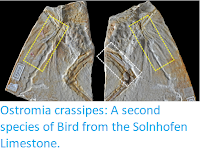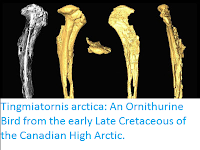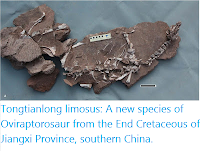The Paravians are a group of Maniraptoran Theropod Dinosaurs which includes the Birds, plus their closest relatives the Dromaeosaurs, Troodontids, Anchionithids, and Scansorioptererygids. Most of species of these Dinosaurs are known from the Late Jurssic and Cretaceous (later in the case of Birds) and can be confidently assigned to one of the derived groups that make up the Paraves, however the Middle-Late Jurassic Tiaojishan Formation of Hebei Province in China has produced a number of early Paravian Dinosaurs that appear to date from around the time that these groups diverged and which cannot always be confidently assigned to one group, including some specimens which may be the earliest known Birds (the Tiaojishan Formation is thought to be slightly older than the Solnhofen Limestone which produced the generally accepted first known fossil Bird, Archaeopteryx lithographica.
In a paper published in the journal Nature Communications on 15 January 2017, Dongyu Hu of the Paleontological Museum of Liaoning and Key Laboratory for Evolution of Past Life in Northeast Asia at Shenyang Normal University, Julia Clarke of the Department of Geological Sciences and Integrated Bioscience at the University of Texas at Austin, Chad Eliason, also of the Department of Geological Sciences and Integrated Bioscience at the University of Texas at Austin, and of the Integrative Research Center at the Field Museum of Natural History, Rui Qiu, also of the Paleontological Museum of Liaoning and Key Laboratory for Evolution of
Past Life in Northeast Asia at Shenyang Normal University, Quanguo Li of the State Key Laboratory of Biogeology and Environmental Geology at the China University of Geosciences, Matthew Shawkey of the Evolution and Optics of Nanostructures Group at the University of Ghent, Cuilin Zhao, again of the Paleontological Museum of Liaoning and Key Laboratory for Evolution of
Past Life in Northeast Asia at Shenyang Normal University, Liliana D’Alba, also of the Evolution and Optics of Nanostructures Group at the University of Ghent, Jinkai Jiang once again of the Paleontological Museum of Liaoning and Key Laboratory for Evolution of
Past Life in Northeast Asia at Shenyang Normal University, and Xing Xu of the Key Laboratory of Vertebrate Evolution and Human Origins at the Institute of Vertebrate Paleontology and Paleoanthropology of the Chinese Academy of Sciences, describe a new speciecs of Paravian Dinosaur from the Middle-Late Jurassic Tiaojishan Formation of Hebei Province, China.
The new species is named Caihong juji, where 'Caihong' means 'rainbow' in reference to the insights into the colour of Paravians that the high preservation of this specimens provides, and 'juji' means 'big crest' in reference to the large crests the specimen has on its lacriminal bones (the hind part of its snout). The species is described from a single almost complete specimen preserved on a slab and counter-slab from a layer interpreted as being 171 million years old. Besides the crests the species is distinguished by a robust dentary (jawbone) short ilium (part of the hip).
Caihong juji. Photographs of the slab (a) and counter slab (b) and line drawing (c) of the specimen based on both slabs. Photograph (d) and line drawing (e) of a composite of the rostrum of the skull and mandible exposed on the counter slab and the post-rostrum cranium exposed on the slab. Arrows indicate lacrimal crests. Question mark indicates uncertain identification. Scale bars: 10 cm a–c, 1 cm d and e. aof antorbital fenestra, cav caudal vertebra, cev cervical vertebra, dr dorsal rib, dv dorsal vertebra, ect ectopterygoid, emf external mandibular fenestra, en external naris, f feather, fu furcula, ga gastralia, hy hyoid, il ilium, is ischium, la left angular, lar left articular, lc left coracoid, lcr lacrimal crest, ld left dentary, lf left, frontal, lfe left femur, lh left humerus, lj left jugal, ll left lacrimal, lma left maxilla, lm left manus, ln left nasal, lp left pes, lpa left palatine, lpo left postorbital, lq left quadrate, lqj left quadratojugal, lr left radius, ls left scapula, lsp left splenial, lsa left surangular, lsq left squamosal, lt left tibiotarsus, lu left ulna, ma mandible, mf maxillary fenestra, o orbit, p parietal, pm premaxilla, pt pterygoid, pu pubis, rar right articular, rc right coracoid, rd right dentary, rfe right femur, rh right humerus, rm right manus, rp right pes, rpra right prearticular, rq right quadrate, rr right radius, rs right scapula, rt right tibiotarsus, ru right ulna, scl sclerotic bones, sk skull, sy synsacrum. Hu et al. (2018).
A phlylogenetic analysis suggests that the new species is a member of the Deinonychosaurs (Dromaeosaurids and Troodontids) rather than directly ancestral to the Birds though it does provide insight into a close relative of the first Birds. The specimen has a well preserved feather covering, including what appear to be densely packed melanosomes (colour cells). These would normally be indicative of a dark colour (in the absence of other colour cells, as appears to be the case, black), however those of Caihong juji resemble closely those of iridescent Birds, such as Hummingbirds, which appear to shimmer different colours when seen an angle, suggesting that this Jurassic species may have been similarly iridescent.
See also...
Follow Sciency Thoughts on
Facebook.







